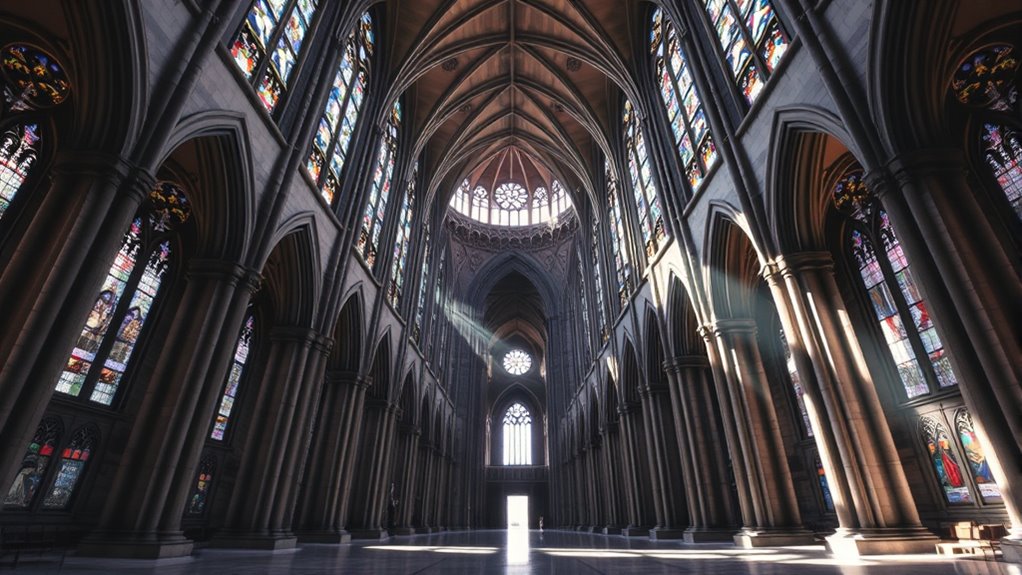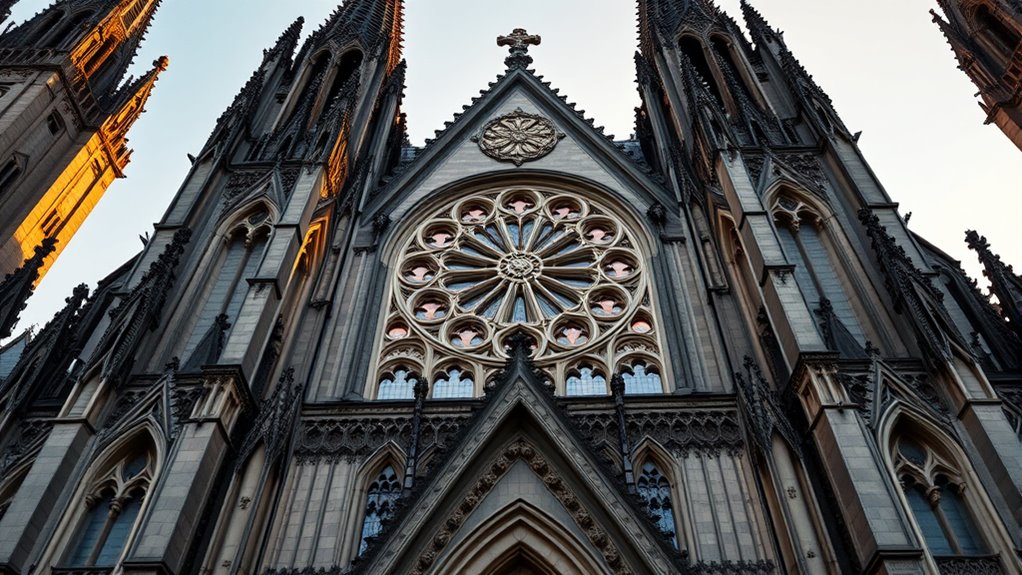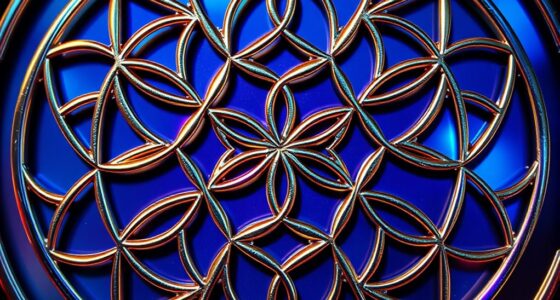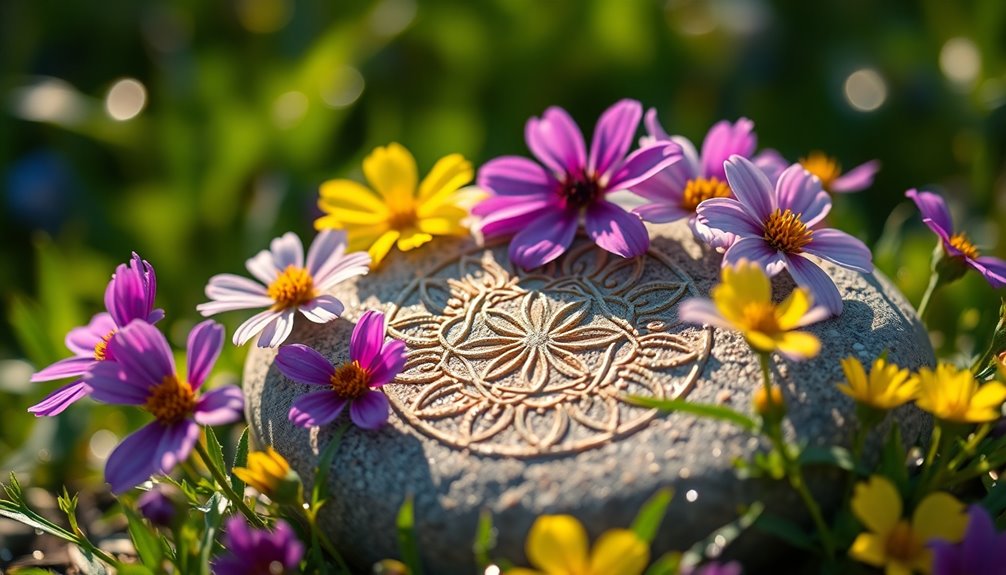Gothic cathedrals showcase sacred proportions and precise mathematical relationships, creating a sense of harmony and spiritual significance. You’ll notice elements like pointed arches, spires, and flying buttresses aren’t just decorative—they symbolize reaching toward the divine. Architects used ratios like the Golden Ratio and Fibonacci sequence to evoke feelings of balance and sacred order. If you explore further, you’ll discover how these mathematical principles transform architecture into a powerful spiritual experience.
Key Takeaways
- Gothic cathedrals employ sacred geometry, like the Golden Ratio, to create harmonious and aesthetically pleasing proportions.
- Architectural elements such as spires and arches symbolize spiritual ascent and divine connection through their proportions.
- The use of mathematical ratios ensures structural stability and reinforces the spiritual harmony of the design.
- Design principles reflect divine order, with proportions embodying universal and sacred patterns.
- The integration of sacred proportion enhances the cathedral’s ability to inspire awe and connect the earthly with the divine.

Have you ever wondered how Gothic cathedrals achieve such awe-inspiring proportions and harmony? The secret lies in their mastery of Gothic architectural symbolism and the precise mathematical significance embedded in their design. These majestic structures aren’t just built to impress; they embody spiritual ideals through carefully crafted proportions that evoke a sense of divine order. Every element, from towering spires to intricate stained glass windows, is purposefully designed to reflect deeper symbolic meanings. The Gothic architectural symbolism often revolves around the idea of reaching toward the heavens, with the verticality and height of the structures symbolizing spiritual ascent and divine connection. The pointed arches, ribbed vaults, and flying buttresses aren’t merely aesthetic choices—they serve to direct the viewer’s eye upward, emphasizing the sacred nature of the space and inspiring awe. Additionally, the use of mathematical ratios like the Fibonacci sequence and Golden Ratio further enhances the harmony and spiritual resonance of these structures. Behind this visual grandeur lies a foundation of mathematical precision. The design of Gothic cathedrals frequently incorporates ratios and proportions rooted in sacred geometry, which heighten their aesthetic harmony. For example, designers often used the Fibonacci sequence or the Golden Ratio, principles known for their naturally pleasing proportions, to determine the dimensions of various structural elements. These ratios aren’t accidental; they’re intentional, reflecting an understanding of how mathematical relationships can evoke a sense of balance and order that resonates on a subconscious level. By applying these mathematical principles, architects ensured that the relationships between walls, windows, and arches create a sense of unity and stability that feels both natural and divine. This combination of symbolism and mathematical significance in design isn’t just about beauty; it’s about creating a space that elevates the spirit and embodies divine harmony. When you stand inside a Gothic cathedral, you’re not just admiring a man-made marvel—you’re experiencing a physical manifestation of sacred principles. The way the proportions align and the symbolism embedded throughout serve to reinforce the spiritual message that these structures aim to communicate. They remind you that architecture, especially in the Gothic tradition, is a bridge between the earthly and the divine, designed with intentionality rooted in universal patterns. It’s this deliberate integration of symbolism and math that makes Gothic cathedrals timeless symbols of faith, inspiring awe and reverence through their perfect harmony.
Frequently Asked Questions
How Did Ancient Builders Determine the Exact Measurements for Sacred Proportions?
You can see that ancient builders determined measurements through ancient measurement techniques like using ropes, rods, and their own body parts, such as palms and feet. They relied on sacred ratio calculations, observing natural patterns and proportions to guarantee harmony. By carefully measuring and comparing these proportions, they achieved precise, consistent results, which reflected their knowledge of sacred geometry and their desire to create structures that embodied spiritual and aesthetic ideals.
Are There Specific Gothic Cathedrals That Exemplify the Perfect Use of Sacred Proportion?
You’ll find that Chartres Cathedral beautifully exemplifies the perfect use of sacred proportion, showcasing Gothic symmetry through sacred ratios. Its harmonious design captivates visitors, illustrating how ancient builders subtly balanced elements for aesthetic and spiritual resonance. The proportions seem almost divine, guiding your eye naturally through the space. As you walk its nave, you experience firsthand how sacred ratios create a sense of unity and perfection, making it a timeless masterpiece of Gothic architecture.
How Did Sacred Proportions Influence Other Architectural Styles Beyond Gothic?
Sacred proportions greatly influenced other architectural styles by emphasizing proportional harmony and aesthetic balance. You’ll notice these principles in Renaissance architecture, where artists and architects use ratios like the golden ratio to create visually pleasing structures. This approach extends to classical Greek and Roman designs, inspiring modern architecture as well. Sacred proportions help guarantee buildings evoke harmony, beauty, and a sense of order that resonates across various styles.
What Tools or Methods Did Medieval Architects Use to Achieve Precise Proportions?
Like a painter with a finely sharpened brush, medieval architects relied on simple yet effective measuring techniques and construction tools to achieve precise proportions. They used tools such as the compass, square, and plumb line, along with geometric principles, to guarantee accuracy. These methods allowed them to create harmonious, well-proportioned structures that have stood the test of time, showcasing their mastery of mathematical artistry.
Do Modern Architects Intentionally Incorporate Sacred Proportions in Contemporary Designs?
Yes, modern architects intentionally incorporate sacred proportions to enhance aesthetic harmony in their designs. They use mathematical ratios like the Golden Ratio to create visually appealing structures that resonate naturally with viewers. By applying these principles, you can achieve balance and beauty in contemporary architecture, blending traditional concepts with innovative techniques. This deliberate use of sacred proportions helps you craft spaces that feel both harmonious and timeless, elevating modern design to new levels.
Conclusion
As you walk through these majestic cathedrals, you’ll notice how the sacred proportion gently guides your gaze upward, like a whisper of divine harmony. It’s as if the architecture softly cradles you in a timeless embrace, inviting your spirit to soar beyond the earthly domain. In this delicate balance, every curve and line hints at a divine mystery, leaving you with a sense of wonder that lingers softly, like a gentle breeze brushing against your soul.










